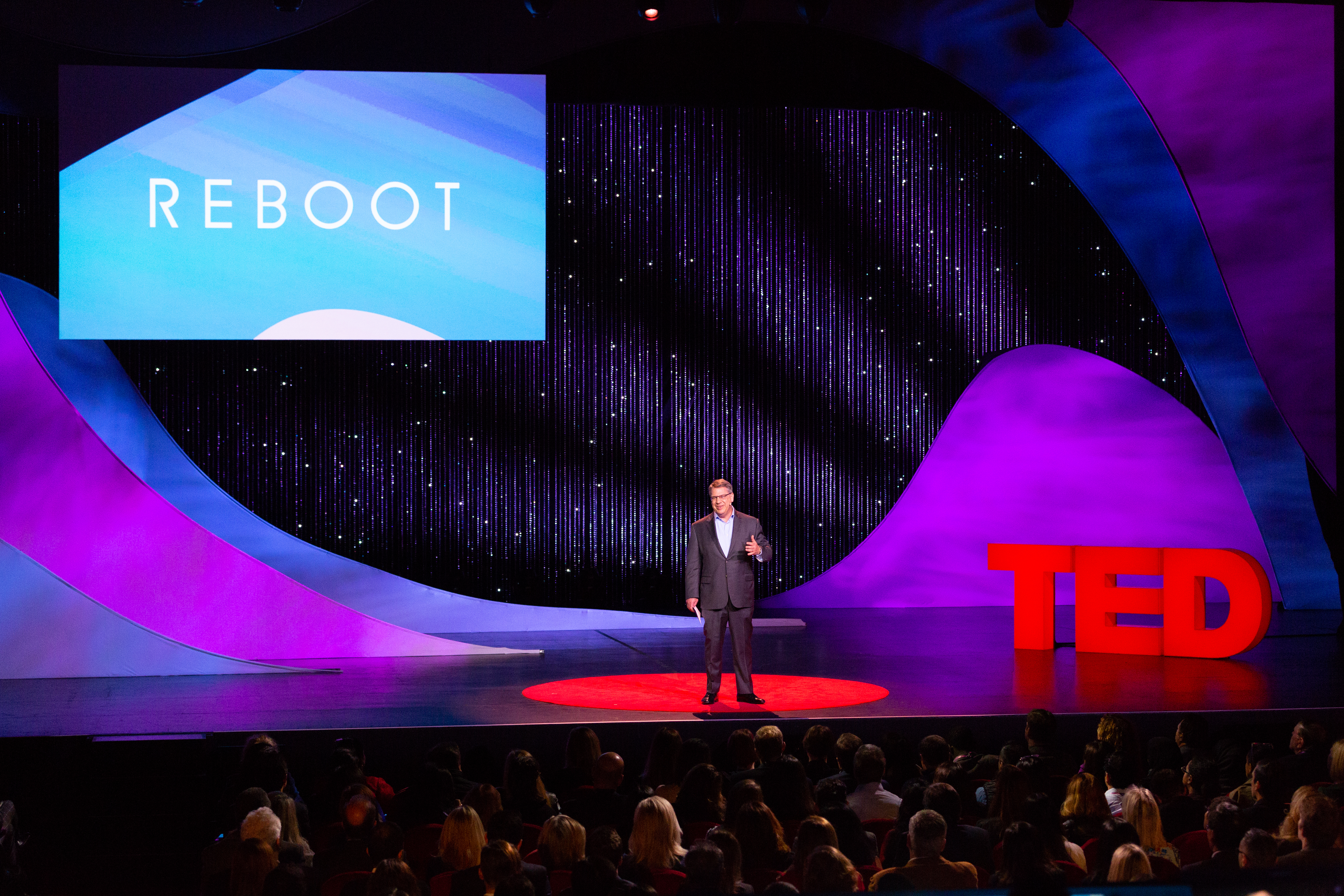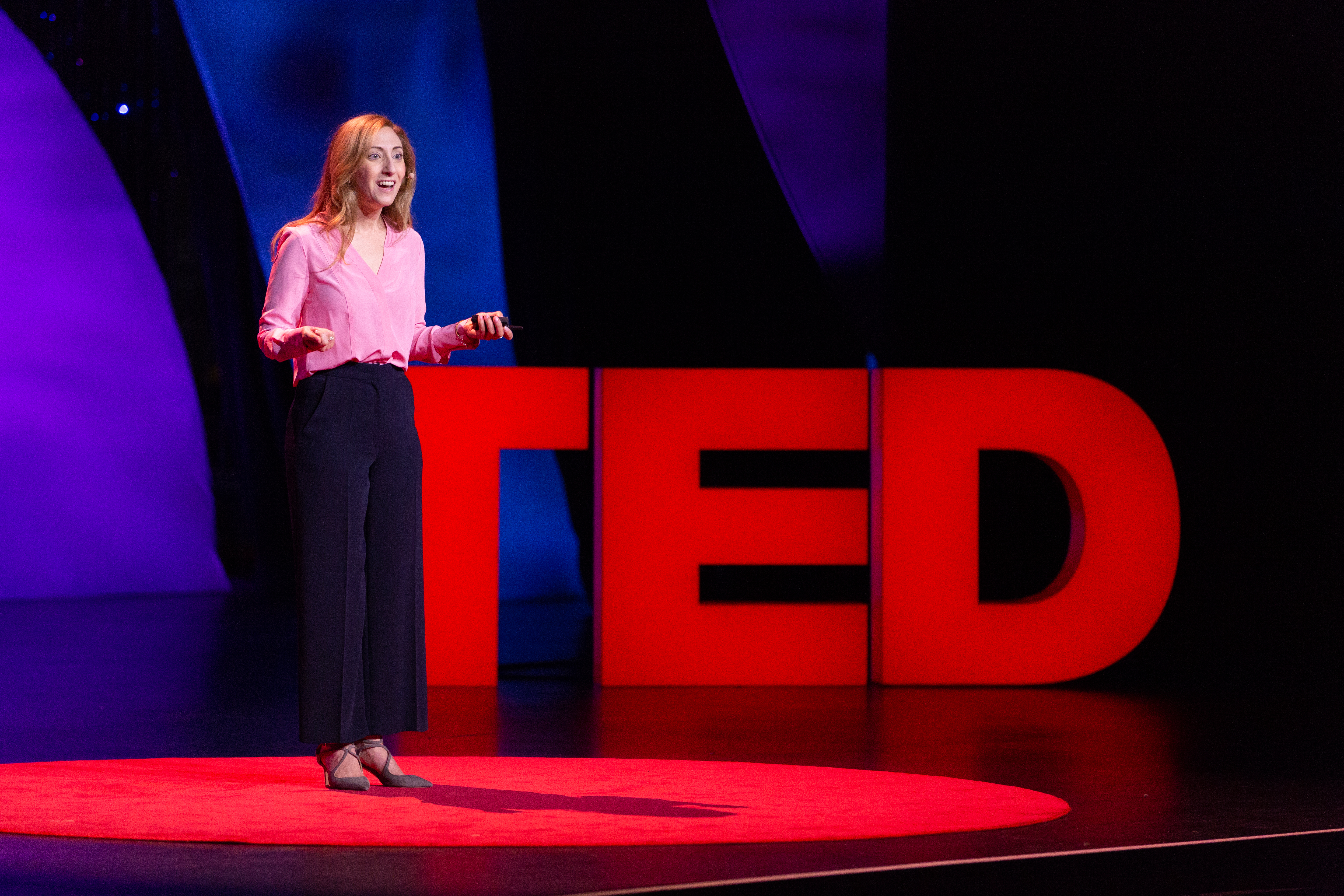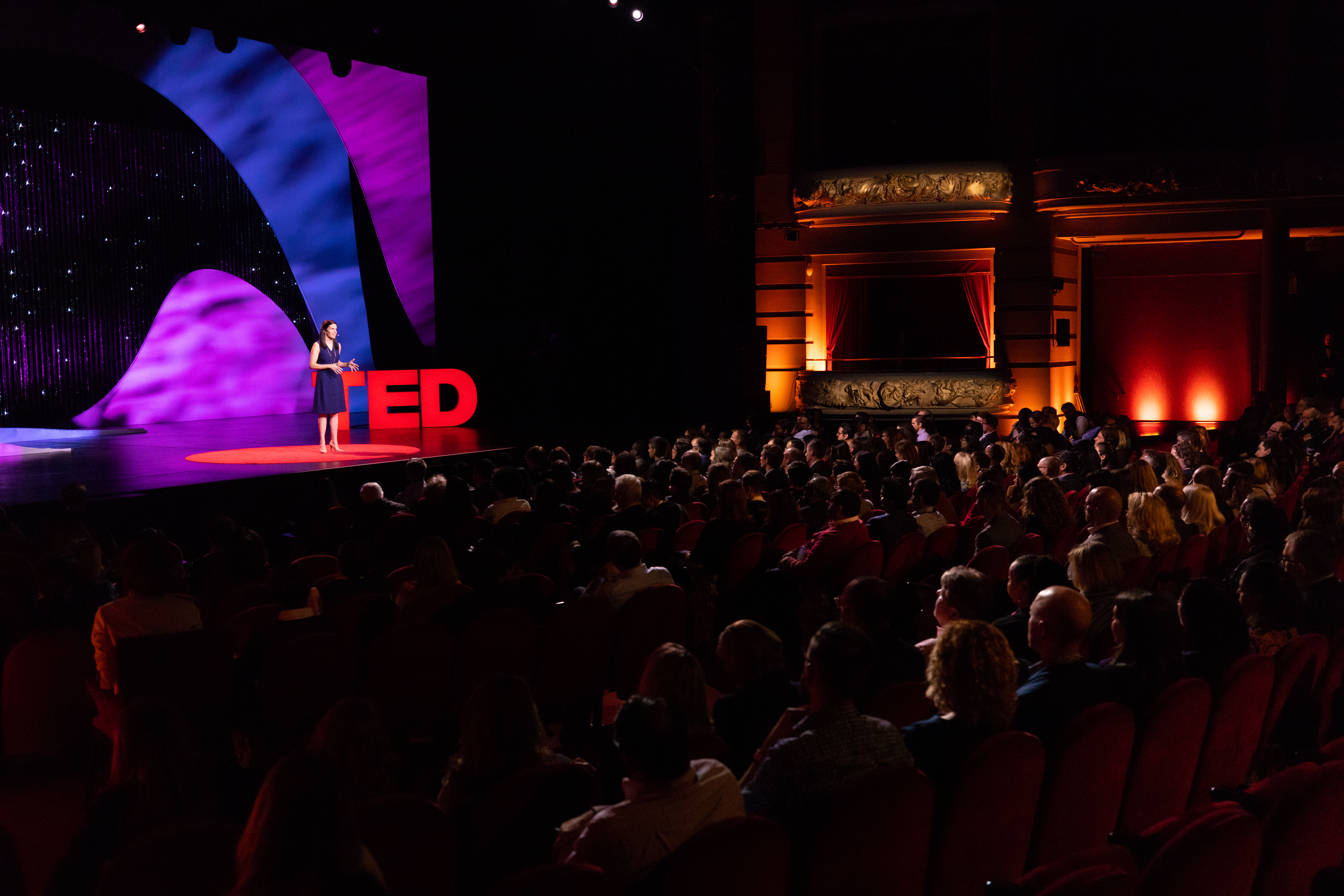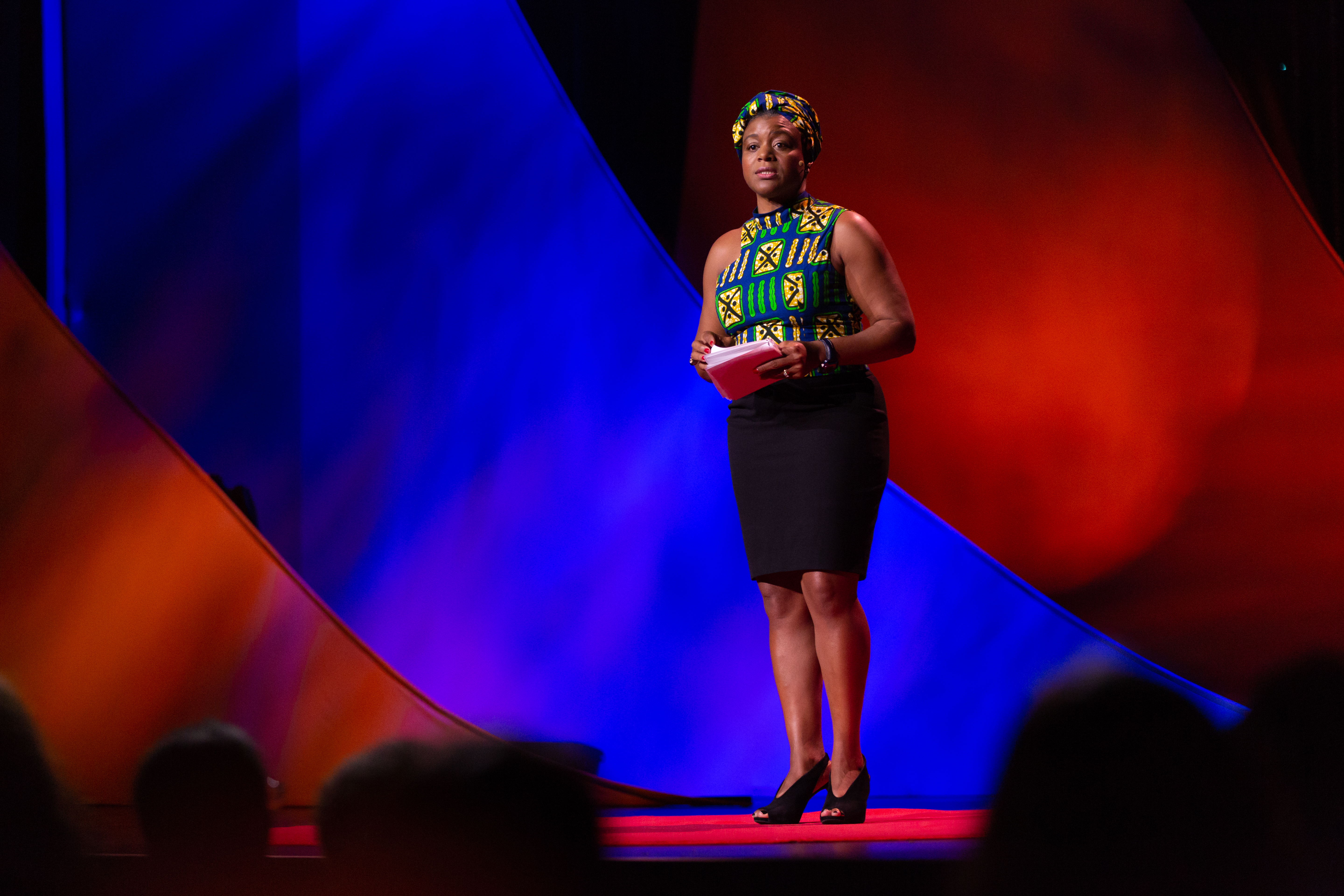
CEO of BCG, Rich Lesser, welcomes the audience to TED@BCG, held October 3, 2018, at Princess of Wales Theatre in Toronto. (Photo: Ryan Lash / TED)
How do we manage the transformations that are radically altering our lives — all while making a positive impact on our well-being, productivity and the world? In a word: reboot.
For a seventh year, BCG has partnered with TED to bring experts in leadership, psychology, technology, sustainability and more to the stage to share ideas on rethinking our goals and redefining the operating systems we use to reach them. At this year’s TED@BCG — held on October 3, 2018, at the Princess of Wales Theater in Toronto — 18 creators, leaders and innovators invited us to imagine a bright future with a new definition of the bottom line.
After opening remarks from Rich Lesser, CEO of BCG, the talks of Session 1 …
Let’s stop trying to be good. “What if I told you that our attachment to being ‘good people’ is getting in the way of us being better people?” asks social psychologist Dolly Chugh, professor at NYU’s Stern School of Business. The human brain relies on shortcuts so we can cope with the millions of pieces of information bombarding us at any moment. That’s why we’re often able to get dressed or drive home without thinking about it — our brains are reserving our attention for the important stuff. In her research, Chugh has found the same cognitive efficiency occurs in our ethical behavior, where it shows up in the form of unconscious biases and conflicts of interest. And we’re so focused on appearing like good people — rather than actually being them — that we get defensive or aggressive when criticized for ethical missteps. As a result, we never change. “In every other part of our lives, we give ourselves room to grow — except in this one where it matters the most,” Chugh says. So, rather than striving to be good, let’s aim for “good-ish,” as she puts it. That means spotting our mistakes, owning them and, last but not least, learning from them.

You should take your technology out to coffee, says BCG’s Nadjia Yousif. She speaks at TED@BCG about how we can better embrace our tech — as colleagues. (Photo: Ryan Lash / TED)
Treat your technology like a colleague. “The critical skill in the 21st-century workplace is … to collaborate with the technologies that are becoming such a big and costly part of our daily working lives,” says technology advisor Nadjia Yousif. She’s seen countless companies invest millions in technology, only to ignore or disregard it. Why? Because the people using the technology are skeptical and even afraid of it. They don’t spend the time learning and training — and then they get frustrated and write it off. What if we approached new technology as if it were a new colleague? What if we treated it like a valued member of the team? People would want to get to know it better, spend time integrating it into the team and figure out the best ways to collaborate, Yousif says — and maybe even give feedback and make sure the tech is working well with everyone else. Yousif believes we can treat technology this way, and she encourages us to “share a bit of humanity” with our software, algorithms and robots. “By embracing the ideas that these machines are actually valuable colleagues, we as people will perform better … and be happier,” she says.
Confessions of a reformed micromanager. When Chieh Huang started the company Boxed out of his garage in 2013, there wasn’t much more to manage than himself and the many packages he sent. As his company expanded, his need to oversee the smallest of details increased — a habit that he’s since grown out of, but can still reference with humor and humility. “What is micromanaging? I posit that it’s actually taking great, wonderful, imaginative people … bringing them into an organization, and then crushing their souls by telling them which font size to use,” he jokes. He asks us to reflect on the times when we’re most tired at work. It probably wasn’t those late nights or challenging tasks, he says, but when someone was looking over your shoulder watching your every move. Thankfully, there’s a cure to this management madness, Huang says: trust. When we stop micromanaging the wonderfully creative people at our own companies, he says, innovation will flourish.
Dancing with digital titans. Tech giants from the US and China are taking over the world, says digital strategist François Candelon. Of the world’s top 20 internet companies, a full 100 percent of them are American or Chinese — like the US’s Alphabet Inc. and Amazon, and China’s Tencent and Alibaba. Europe and the rest of the world must find a way to catch up, Candelon believes, or they will face US-China economic dominance for decades to come. What are their options for creating a more balanced digital revolution? Candelon offers a solution: governments should tango with these digital titans. Instead of fearing their influence — as the EU has done by levying fines against Google, for instance — countries would be better off advocating for the creation of local digital jobs. Why would companies like Facebook or Baidu be willing to tango with governments? Because they can offer things like tax incentives and adapted regulations. Candelon points to “Digital India,” a partnership between Google and the government of India, as an example: one of the project’s initiatives is to train two million Indian developers in the latest technologies, helping Google develop its talent pipeline while cultivating India’s digital ecosystem. “Let’s urge our governments and the American and Chinese digital titans to invest enough brainpower and energy to imagine and implement win-win strategic partnerships,” Candelon says. The new digital world order depends on it.
Upcycling air pollution into ink. In 2012, a photo of an exhaust stain on a wall sparked a thought for engineer Anirudh Sharma: What if we could use air pollution as ink? A simple experiment with a candle and vegetable oil convinced Sharma that the idea was viable, leading him home to Bangalore to test how to collect the carbon-rich PM2.5 nanoparticles that would make up the ink. Sharma and his team at AIR INK created a device that could capture up to 95 percent of air pollution that passed through it; using it, 45 minutes of diesel car exhaust can become 30 milliliters of ink (or about 2 tablespoons). Artists worldwide embraced AIR INK, and this success brought surprising interest from the industrial world. Sharma realized that by incentivizing corporations to send their pollution to AIR INK, they could upcycle pollution usually headed for landfills into a productive tool. AIR INK won’t necessarily solve global pollution concerns, Sharma says, “but it does show what can be done if you look at problems a little differently.”
Leadership lessons for an uncertain world. Jim Whitehurst is a recovering know-it-all CEO. Kicking off Session 2, Whitehurst tells the story of how his work as the COO of Delta trained him to think that a good leader was someone who knew more than anyone else. But after becoming CEO of RedHat, an open-source software company, Whitehurst encountered a different kind of organization, one where open criticism of superiors — and not exactly following a boss’s orders — were normal. This experience yielded insights about success and leadership, as Whitehurst came to realize that being a good leader isn’t about control and compliance, it’s about creating the context for the best ideas to emerge out of your organization. “In a world where innovation wins and ambiguity is the only certainty, people don’t need to be controlled,” Whitehurst says. “They need to get comfortable with conflict. And leaders need to foment it.”

Elizabeth Lyle shares ideas on the future of leadership in the workplace at TED@BCG. (Photo: Ryan Lash / TED)
Why we need to coach people before they lead. The C-suites of corporate America are full of management coaches, yet top-tier execs are not the ones who really need the help, says Elizabeth Lyle, a principal in BCG’s Boston office. “Outdated leadership habits are forming right before our eyes among the middle managers who will one day take their place,” she says. While the uncertain future of work demands new ways of thinking, acting and interacting, tomorrow’s leaders aren’t given the autonomy or training they need to develop — and they don’t ask for it, lest they seem pushy and disagreeable. They also think that they’ll be able to change their behavior once they’ve earned the authority to do things their own way, Lyle says, but this rarely happens. By the time they’re in a high-stakes position, they tend to retreat to doing what their bosses did. The solution: senior leaders must present their direct reports with the opportunities to try new things, and reports should return that trust by approaching their work with thought and creativity. Lyle also suggests bringing in coaches to work in the same room with leaders and reports — like a couples therapist, they’d observe the pair’s communication and offer ideas for how to improve it.
A breakdown, and a reboot. Each of us feels the burden of daily repetitive actions on our bodies and psyches, whether we create them or they’re imposed by outside forces. Left unchecked, these actions can “turn into cages,” says Frank Müller-Pierstorff, Global Creative Director at BCG. In an electronic music performance, he uses soundscapes built out of dense, looped phrases to embody these “cages,” while dancer Carlotta Bettencourt attempts to keep up in an accompanying video — and ultimately shows us what might happen if we could only “reboot” under the weight of our stress.
WWMD? What would MacGyver do? That’s what Dara Dotz asks herself, whether she’s working to help build the first factory in space or aiding survivors of a recent catastrophic event. Much like the fictional genius/action hero, Dotz loves to use technology to solve real-life problems — but she believes our increasing reliance on tech is setting us up for major failure: Instead of making us superhuman, tech may instead be slowly killing our ability to be creative and think on our feet. If disaster strikes — natural or man-made — and our tech goes down, will we still have the ingenuity, resilience and grit to survive? With that concern in mind, Dotz cofounded a nonprofit, Field Ready, to support communities that experience disasters by creating life-saving supplies in the field from found materials and tools. With real-world examples from St. Thomas to Syria, Dotz demonstrates the importance of co-designing with communities to create specific solutions that fit the need — and to ensure that the communities can reproduce these solutions. “We aren’t going to be able to throw tech at every problem as efficiently or effectively as we would like — as time moves on, there are more disasters, more people and less resources,” she says. “Instead of focusing on the next blockchain or AI, perhaps the things we really need to focus on are the things that make us human.”
Rebooting how we work. What are we willing to give up to achieve a better way of working? For starters: the old way of doing things, says Senior Partner and Managing Director of BCG Netherlands, Martin Danoesastro. In a world that’s increasingly complex and fast-paced, we need a way of working that allows people to make faster decisions, eliminates bureaucracy and creates alignment around a single purpose. Danoesastro learned this firsthand by visiting and studying innovative and hugely profitable tech companies. He discovered the source of their success in small, autonomous teams that have the freedom to be creative and move fast. Danoesastro provides a few steps for companies that want to replicate this style: get rid of micro-managers, promote open and transparent communication throughout the organization, and ensure all employees take initiative. Changing deeply ingrained structures and processes is hard, and changing behavior is even harder, but it’s worth it. Ultimately, this model creates a more efficient workplace and sets the company up for a future in which they’ll be better prepared to respond to change.
The power of visual intelligence. Are you looking closely enough? Author Amy Herman thinks we should all increase our perceptual intelligence — according to Herman, taking a little more time to question and ponder when we’re looking at something can have lasting beneficial impact in our lives. Using a variety of fine art examples, Herman explains how to become a more intentional, insightful viewer by following the four A’s: assess the situation, analyze what you see, articulate your observations and act upon them. Herman has trained groups across a spectrum of occupations — from Navy SEALS to doctors to crime investigators — and has found that by examining art, we can develop a stronger ability to understand both the big picture and influential small details of any scene. By using visual art as a lens to look more carefully at what’s presented to us, Herman says, we’ll have the confidence to see our work and the world clearer than ever.

Fintech entrepreneur Viola Llewellyn shares her work pairing AI with local knowledge to create smarter products for the African market. (Photo: Ryan Lash / TED)
Culturally attuned microfinance for Africa. Financial institutions in Africa’s business sector don’t have the technology or tools to harness the continent’s potential for wealth, says fintech entrepreneur Viola Llewellyn, opening Session 3. The continent is made up of thousands of ethnic groups speaking more than 2,000 languages among them, rooted in a long, rich history of cultural diversity, tradition and wealth. “You need a deep understanding of nuance and history,” Llewellyn says, “and a respect for the elegance required to code and innovate [financial] products and services for the vast African market.” She cofounded Ovamba, a mobile technology company, to bridge the gap in knowledge between institutions and African entrepreneurs. Working with teams on the ground, Ovamba pairs human insights about local culture with AI to create risk models and algorithms, and ultimately product designs. Llewellyn highlights examples across sub-Saharan Africa that are successfully translating her vision into real-world profit. “In digitizing our future, we will preserve the beauty of our culture and unlock the code of our best wealth traits,” she says. “If we do this, Africans will become global citizens with less reliance on charity. Becoming global citizens gives us a seat at the table as equals.”
Globalization isn’t dead — it’s transforming into something new. All the way up to Davos, business leaders have proclaimed the death of globalization. But Arindam Bhattacharya thinks their obituary was published prematurely. Despite growing economic protectionism, and the declining influence of multilateral trade organizations, business is booming. Technology has allowed data-driven businesses like Netflix to reach their customers instantly and simultaneously — and as a result, Netflix revenues have grown more than five-fold. Netflix is one of a new breed of companies using cutting-edge technology to build “a radical new model of globalization.” And it’s not just data — soon, 3D printing will redefine our supply chains. Working with the manufacturer SpeedFactory, Adidas allows customers to choose designs online, have them printed at a nearby “mini-factory,” and delivered via drone in a matter of days, not weeks or months. Aided by local production, cross-border data flow could be worth $20 trillion by 2025 — more than every nation’s current exports combined. As society becomes “more nationalistic and less and less open,” Bhattacharya says, commerce is becoming more personalized and less tied to cross-border trade. These twin narratives are reinvigorating globalization.
Viruses that fight superbugs. Viruses have a bad reputation — but some might just be the weapon we need to help in the fight against superbugs, says biotech entrepreneur Alexander Belcredi. While many viruses do cause deadly diseases, others can actually help cure them, he says — and they’re called phages. More formally known as bacteriophages, these viruses hunt, infect and kill bacteria with deadly selectivity. Whereas antibiotics inhibit the growth of broad range of bacteria — sometimes good bacteria, like you find in the gut — phages target specific strains. Belcredi’s team has estimated that we have at least ten billion phages on each hand, infecting the bacteria that accumulate there. So, why is it likely you’ve never heard of phages? Although they were discovered in the early 20th century, they were largely forgotten in favor of transformative antibiotics like penicillin, which seemed for many decades like the solution to bacterial infections. Unfortunately, we were wrong, Belcredi says: multi-drug-resistant infections — also known as superbugs — have since developed and now overpower many of our current antibiotics. Fortunately, we are in a good place to develop powerful phage drugs, giving new hope in the fight against superbugs. So, the next time you think of a virus, try not to be too judgmental, Belcredi says. After all, a phage might one day save your life.

Madame Gandhi and Amber Galloway-Gallego perform “Top Knot Turn Up” and “Bad Habits” at TED@BCG. (Photo: Ryan Lash / TED)
How music brings us together. “Music is so much more than sound simply traveling through the ear,” says sign language interpreter Amber Galloway-Gallego, during the second musical interlude of the day. In a riveting performance, musician and activist Madame Gandhi plays two songs — her feminist anthems “Top Knot Turn Up” and “Bad Habits” — while Galloway-Gallego provides a spirited sign language interpretation.
Agreeing to disagree. Our public discourse is broken, says behavioral economist Julia Dhar, and the key to fixing it might come from an unexpected place: debate teams. In the current marketplace of ideas, Dhar says, contempt has replaced conversation: people attack each other’s identity instead of actually hashing out ideas. If we turn to the principles of debate, Dhar believes we can learn how to disagree productively — over family dinners, during company meetings and even in our national conversations. The first principle she mentions is rebuttal: “Debate requires that we engage with a conflicting idea directly, respectfully and face-to-face,” she says — and as research shows, this forces us to humanize the “other side.” Second, ideas are totally separate from the identity of the person advocating for them in debate tournaments. Dhar invites us to imagine if the US Congress considered a policy without knowing if it was Democrat or Republican, or if your company submitted and reviewed proposals anonymously. And third, debate lets us open ourselves up to the possibility of being wrong, an exercise that can actually make us better listeners and decision makers. “We should bring [debate] to our workplaces, our conferences and our city council meetings,” Dhar says — and begin to truly reshape the marketplace of ideas.
A better world through activist investment. Who’s working on today’s most pressing issues? Activist investors, says BCG’s Vinay Shandal, or as he calls them: “the modern-day OGs of Wall Street.” These investors — people like Carl Icahn, Dan Loeb and Paul Singer — have made an art of getting large corporations to make large-scale changes. And not just to make money. They’re also interested in helping the environment and society. “The good news and perhaps the saving grace for our collective future is that it’s more than just an act of good corporate citizenship,” Shandal says. “It’s good business.” Shandal shares examples of investors disrupting industries from retail to food service to private prisons and shows growing evidence of a clear correlation between good ESG (environmental, social and governance) investing and good financial performance. You don’t need to be a rich investor to make a difference, Shandal says. Every one of us can put pressure on our companies, including the ones that manage our money, to do the right thing. “It’s your money, it’s your pension fund, it’s your sovereign wealth fund. And it is your right to have your money managed in line with your values.” Shandal says. “So speak up … Investors will listen.”